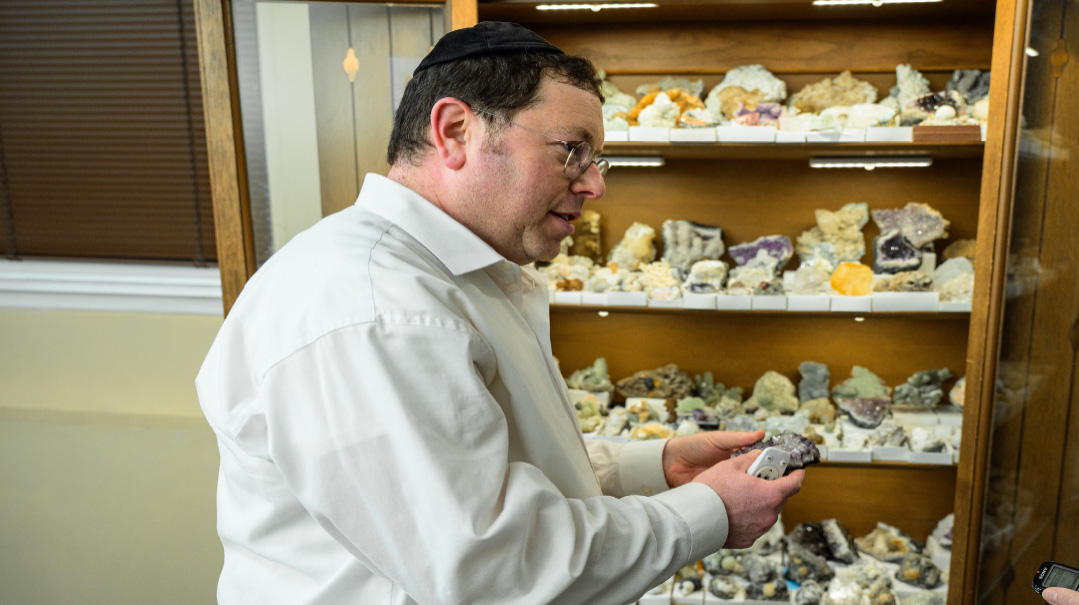Mountain Fever
| February 7, 2023We assume Har Sinai is somewhere deep in Sinai, but Ari and Ari pursue a lead in the Saudi Desert
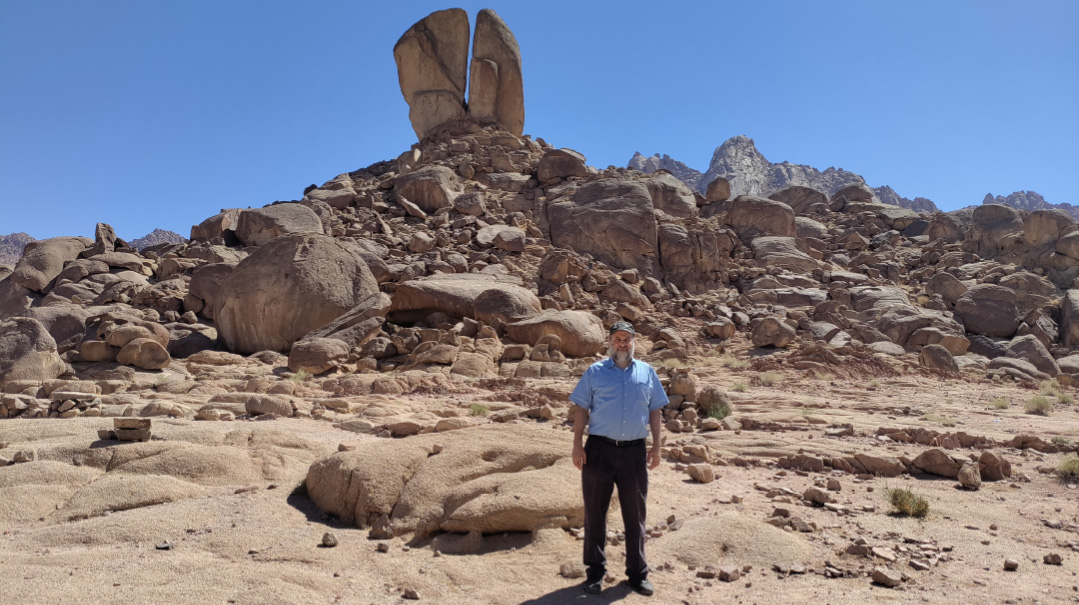
Photos by Ari Z. Zivotofsky and Ari Greenspan
Think about Bnei Yisrael on their march to receiving the Torah, and you automatically assume Har Sinai is somewhere deep in the Sinai Peninsula between Israel and Egypt. But following the pesukim, the humble mountain may well be at the tip of Saudi Arabia, just over the Jordanian border. With this new information and a Saudi visa, we just had to see it for ourselves
Standing on a mountaintop looking out over a vast desert in the intense Saudi Arabian sun, we wondered if we were in the right place. We’d been researching the idea that Har Sinai was not located in the Sinai Peninsula, as is generally thought, but was actually in northwestern Saudi Arabia, a theory espoused by an assortment of scholars, including evangelical Christians and a Tanach researcher who happens to be a longtime Ponevezh avreich.
We had always perceived Saudi Arabia as a closed, forbidding place under strict Muslim rule, where liquor is banned, women can’t show themselves, and Jews cannot visit. Saudi Arabia is the birthplace of Islam and of its founder Mohammed, and is the caretaker of Islam’s two holiest cities: Mecca, where every Muslem has a religious obligation to visit once in his life, and Medina. Several years ago while en route to visit the isolated dictatorship of Eritrea, our Lufthansa flight made a stop in the Saudi capital city of Riyadh to let passengers off, and we were shocked to see that before crossing into Saudi airspace, all the liquor on the plane was locked up and the female flight attendants had to cover themselves. Yet here we were on a very hot summer day in 2022, trying to evaluate the route Bnei Yisrael might have taken to enter the Promised Land.
Although the Shechinah no longer overtly rests on Har Sinai as it did while the universe stood still during the Divine Revelation, and identifying or visiting the site would not involve any brachah or mitzvah, there’s still something tantalizing about visiting the place where our forefathers stood to receive the Torah after they left Egypt 3,500 years ago, a humble mountain suspended somewhere between heaven and earth.
While there is not much subsequent mention of Har Sinai in the Torah, it was not totally forgotten. In one of the most dramatic stories in Tanach, King Achav’s wicked wife Izevel threatens to kill Eliyahu, who then flees to Be’er Sheva and continues into the desert where he prays for G-d to end his life. Instead, G-d sends him on a long journey of 40 days and 40 nights to, of all places, Har Chorev, i.e. Mount Sinai. He enters a cave, and it is here that, in a Moses-like scenario in the crook of the rock, Hashem reveals the secret of where He can be found — in the “still small voice” (I Melachim 19).
When we learned that at least one of the 13 or more suggested locations of Har Sinai is in Saudi Arabia, and that recent events had decreased our security concerns, we decided to explore the theory. We also realized that we would not be the only Jews led to Har Sinai by an Arab. In a series of tales told by Rabbah bar bar Chanah (Bava Basra 74a), he describes being led to Har Sinai by an Arab merchant. He reports seeing it surrounded by scorpions and hearing a bas kol lamenting Hashem’s having sworn to exile the Jews. We were hoping that our Arab guide would not lead us to a scorpion-filled site and did not anticipate hearing Heavenly voices, but who knows?
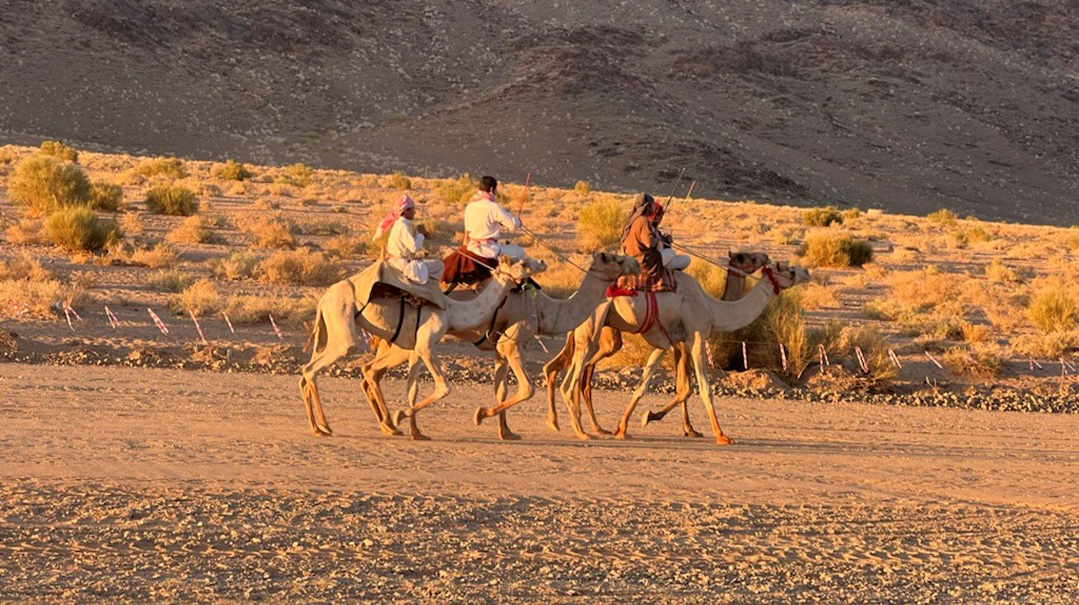
Seeing is Believing
From the cryptic pesukim, little is known about the route of the Exodus from Egypt. What we do know is that when Moshe fled from Egypt the first time, he went to Midian where he lifted off the cover of the well for his soon-to-be wife, the daughter of the local priest Yisro. Moshe worked as a shepherd and was led to the Burning Bush on Mount Sinai, also known as Har Chorev. Soon after, on his way from Midian back to Egypt, his brother Aharon met him at Chorev. After the Ten Plagues, Moshe led the Jewish nation out of slavery, through the desert toward the Land of Canaan/Eretz Yisrael. But what exactly was their travel path, and where did Har Sinai fit in the itinerary?
We are told of the concern that they might change their minds and quickly return to Egypt. So the nation is rerouted to the desert, which is when Pharaoh says they are encircled by the desert and confused, and then sends his army and chariots to bring them back as slaves. With Bnei Yisrael’s backs to the wall, with the Egyptians behind and the sea in front, things looked bleak. But Hashem miraculously split the sea, the nation walked through, and the Egyptians were drowned. From there Bnei Yisrael journeyed to Har Sinai and received the Torah. But where exactly on the map did all this happen? And, does it matter if we know?
The Torah in many places gives information about the travels of Bnei Yisrael, and in parshas Masei (Bamidbar 33), the text goes into great detail delineating all of the encampments in the desert. Obviously, the Torah felt it important for us to be aware of all these details. But why? The Rishonim give a variety of reasons. The Rambam in Moreh Nevuchim (3:50), cited by the Ramban on Chumash (Bamidbar 33:1), reasons that it’s for future generations to see how inhospitable and desolate these places are and how distant they are from any fertile or habitable area, thereby proving that this was no natural journey and arousing awareness of the miracles at the hand of G-d in sustaining Bnei Yisrael. But this reason only makes sense if we know where these places are and can see for ourselves that they are indeed uninhabitable. Well, if the Tabuk region of Saudi Arabia is indeed the location of Har Sinai, we can attest to it being naturally inhospitable.
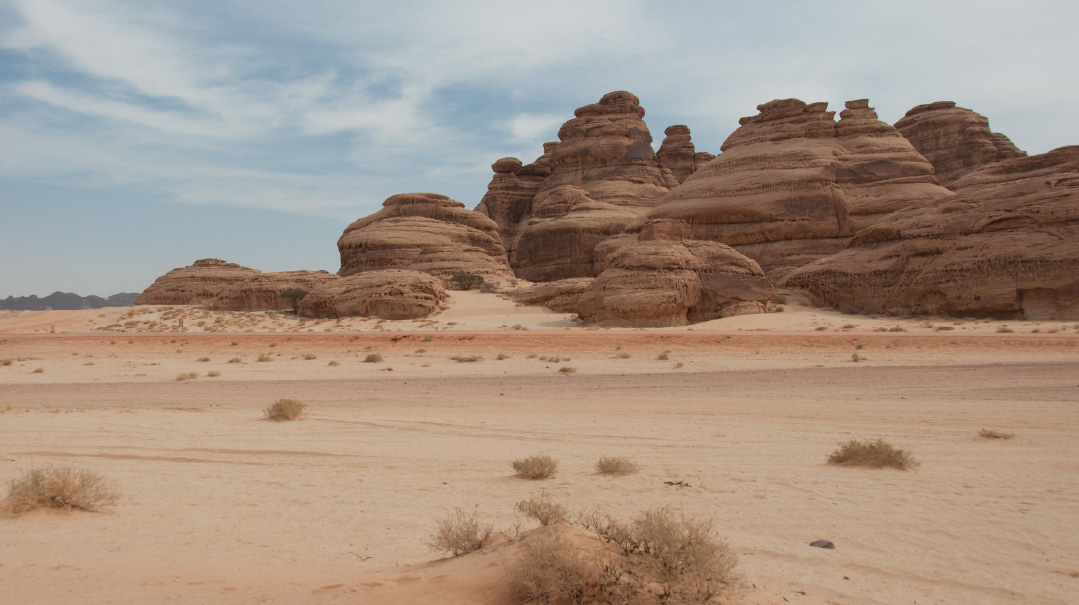
If the Tabuk region of Saudi Arabia is indeed the location of Bnei Yisrael’s sojourn, we can attest to its inhospitable terrain. No wonder they needed water from a rock and protection of the Clouds of Glory
Humble Hill
Putting the pieces together, then, where is Har Sinai? Out of the many locations that have been put forth by scholars over the years, the one with the longest continuous tradition is the mountain in the south-central Sinai Peninsula known by its Arabic name Jabal Musa (“Har Moshe”), identified over 1,500 years ago, and today the site of the Saint Catherine’s Monastery. That mountain is still a popular tourist site, although it’s now in Egyptian territory as part of the Camp David Accords.
It is at this site where one can still find the famous “Sinai stones” about which Rav Yaakov Emden wrote (Migdal Oz, 220b), that have on them an image of the sneh, and indeed no matter how one breaks the rocks in the area, the grain seems to resemble a fern-like “Burning Bush.”
Most other theories also place Mount Sinai in the Sinai Peninsula, although some researchers believe it’s in the western Negev. But within the last few decades, two theories — from very different sources — place it in Saudi Arabia. In 1926, explorer Alois Musil identified Mount Bedr in Saudi Arabia as Mount Sinai, a theory supported by a Cambridge professor as recently as 2004. Beginning in the 1980s, a group of evangelical Christians identified Jebel al-Lawz, a mountain in Saudi Arabia about 100 miles southeast of Eilat, as Mount Sinai.
Coming from a radically different background, London-born Rabbi Alexander Hool, who spent several years in Gateshead Yeshiva and is in his third decade in Ponevezh, has analyzed the biblical and rabbinic sources, and concluded that Mount Sinai is indeed located in northwestern Saudi Arabia, just east of Eilat and the Sinai Peninsula and close to the country’s border with Jordan. Rabbi Hool, however, rejects the Jabal al-Lawz identification for various reasons, one being that it’s one of the highest peaks in this sandy, desert country, while the Gemara (Sotah 5a) says that Hashem chose Mount Sinai specifically because it was a low, humble mountain. Still, convinced that Har Sinai is in the Saudi Arabian desert, he identifies it with a mountain further south, called Jabal Harb — which certainly sounds like it preserves the name Chorev.
Rabbi Hool’s groundbreaking theory, in line with a clear analysis of pesukim, Chazal, and in conjunction with modern satellite imagery and mapping technology, can be further explored in his book, Searching for Sinai. Rabbi Hool actually began his research when he was working on another project — ascertaining the exact southern border of Eretz Yisrael with regard to shemittah, which would involve pinpointing the location of Kadesh Barnea with respect to Har Sinai.
He uses the first pasuk in parshas Beshalach as a springboard, in which the straightforward implication is that the natural path from Egypt to Sinai was via the land of the Pelishtim, which lay at the southern border of Canaan, at the far north of the Sinai Peninsula. And moving east toward Sinai, located in what he believes is today Saudi Arabia, Bnei Yisrael would have also passed by the Red Sea a second time — as stated in the list of encampments in parshas Masei — at Eilat on the tip of the eastern arm of the Red Sea, the Gulf of Aqaba. And the entrance into Saudi Arabia at this point would seem to match with the entry into a different wilderness called Midbar Tzin.
And so, with all this in mind, a few innocuous (we thought) border crossings, and really just a few hours’ journey by car, how could we resist?
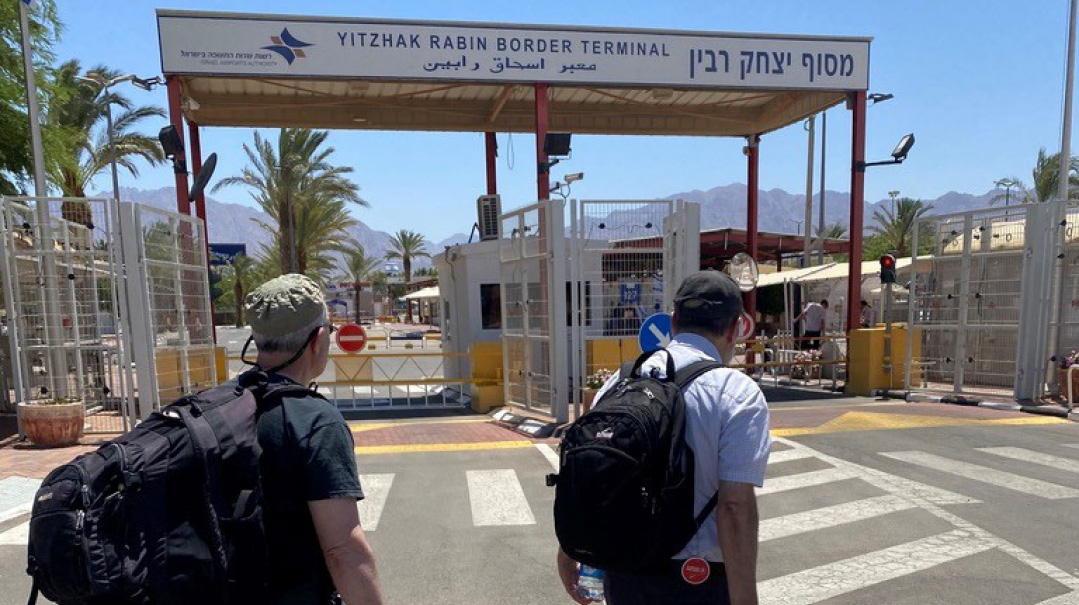
Getting over the Israel part of the border was a cinch. Little did we know what lay in store for us in Jordan, our partner in peace
Border Ahead
Although there are rumblings of additional peace initiatives, one cannot yet enter Saudi Arabia with an Israeli passport, so in what proved to be an easy task, we purchased Saudi visas online using our US passports. When we plan a halachic adventure, we look at the history and geography of a location, evaluate personal security and health issues, research any Jewish sites, and try to uncover any Jews living there. When we started planning this trip by air, we soon realized that our destination in this massive country was not near any of the large Saudi cities but rather was actually very close to Israel over land.
“Hey, why don’t we drive?” At first the idea seemed nuts, but then, looking at the map, it really made sense. The northwestern border of Saudi Arabia is a mere 30-minute drive from the Israeli border between Eilat and Aqaba, Jordan. We arranged for a Saudi tour guide and a car to meet us at the Jordanian side of the Israel/Jordan border, and estimated we would need three relaxed days in Saudi Arabia to see everything that we’d planned. Little did we know that we were about to endure one of the most unpleasant travel experiences of our lives in the 50-plus countries we have been to. And it was with our peace partner, Jordan.
Granted, the peace with Jordan is a cold one. The king sits on a precarious throne, over a population with a high percentage of Palestinian refugees. We arrived at the Yitzhak Rabin Crossing, formerly called the “Arava” crossing, just north of Eilat, having learned that this was the least crowded and easiest of the three land borders between Israel and Jordan. Indeed, there was no line, and passing Israeli Immigration was easy, efficient, and fast. Pay an exit tax (which by the way, you also pay when you fly, it is just included in the air ticket price so goes unnoticed), put your biometric Israeli passport on the scanner, and walk out of Israel.
But while we were joking about how things had been so fast and smooth, on the Jordanian side of the border it was all about to grind to halt.
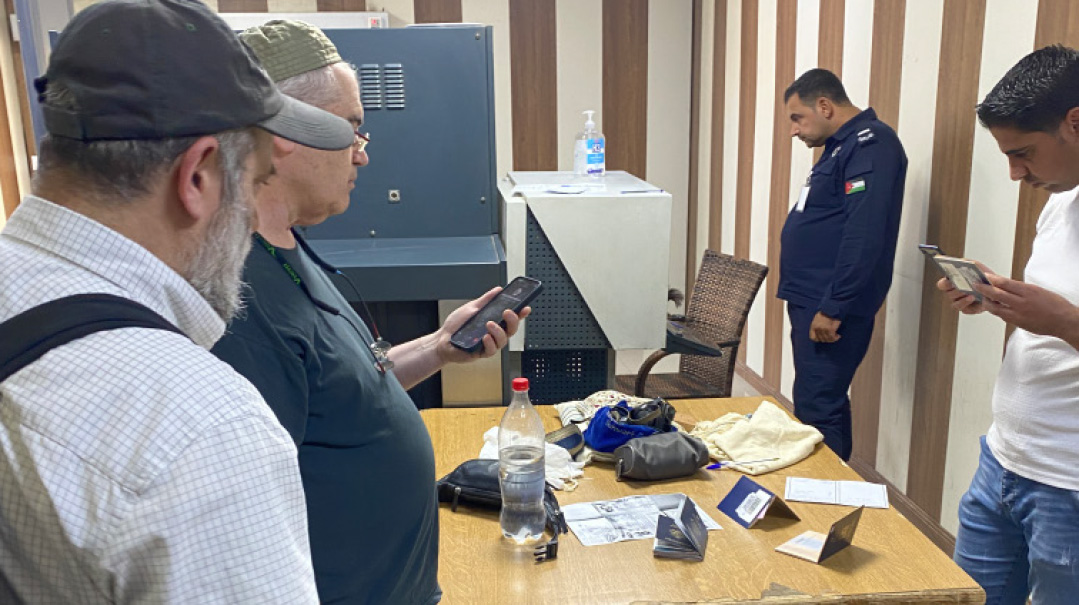
Confiscated contraband, “for our own safety”
Nothing Jewish Here
We put our overnight bags on the scanner as we heard the guards muttering “Yahud” — Jews. They whispered to each other in Arabic as they opened up our bags to search, going through every centimeter. But they weren’t looking for weapons or other contraband items — they were looking for Jewish items. One by one, they removed our tallis, tefillin, tzitzis, and Hebrew books. They even had us remove our caps to see if we had kippot, and they then confiscated those as well. All of this “contraband” was piled up on the side of the X-ray machine as they explained to us that the policy in Jordan is that no Jewish items may enter the country, a policy they told us was “for our own safety.”
And then they issued an ultimatum: Either we return all of the religious items to Israel and leave them there while we enter Jordan or we can’t enter the country. Obviously, we could not be without our tefillin for a day even for the sake of visiting Har Sinai, so we made a quick calculation. We’d already forked over a hefty down payment to our Saudi guide who was waiting for us in a Saudi vehicle outside. We tried to argue with them, explaining that we were not entering Jordan but simply transiting, but there was no one to talk to — none of the government workers spoke English (and this was an international border!). We decided to return our tefillin to Israel with the following plan: We’d already donned tefillin that morning, and we’d just do a more intense trip, seeing sites until late at night and restarting at six a.m. the next morning, returning at 3:30 p.m. the following afternoon when the border closes, which would give us enough time for tefillin before shkiah.
And so, we returned all our “sensitive” items to Israel, came back to the border, got visas in our passports and were about to leave, when a uniformed soldier approached Ari Z. to frisk him. He explained to a local guide we hired there on the spot to help us, who spoke English, that he wanted to check if Ari Z. was wearing tzitzis — which he was. When we gave the guide a stern look, he quickly booted the soldier away.
In the end, we spent more time at the Jordanian border crossing than actually driving across Jordan. But after spending an hour and a half with the guards there, we finally understood what at least some of the fuss was about: They asked us if we knew anything about a religious group of 150 Jews waiting to enter Jordan. We missed all the action, but it turns out that the group behind us was headed for Hor HaHar, near Petra, where Aharon HaKohein is buried. And when the Jordanian guards saw the amounts of kosher food and tefillin they had and started to confiscate things, a commotion ensued, and the entire group was barred entry.
(We were quite shocked over the Jordanian policy that obviously represents a decision from much higher up in the government. We have since written to the US Ambassador Thomas Nides and to US Special Envoy for Monitoring and Combating Anti-Semitism, Deborah Lipstadt, both of whom have yet to respond.)
Finally, we went out to meet the Saudi driver we had been in contact with… or so we thought. It turned out that he was not permitted into Jordan because he only had two, not three, Covid shots. He did send another driver, but this next fellow didn’t speak English. (The Jordanian border guards were so focused on confiscating our Jewish material that they never asked us for our proof of vaccination.)
Immediately upon entering Jordan, there was another scam running. The Saudi car was supposedly not allowed in the border area, even though he had actually driven right up to the border. We were forced to take a cab to outside the border area, and only then were we allowed to transfer to our Saudi car, which had followed the Jordanian taxi the entire time.
Thankfully, crossing the Saudi border was much less eventful. And there, on the side of a mountain, was a welcome fitting for a religious country — a massive sign in Arabic declaring that G-d is great.
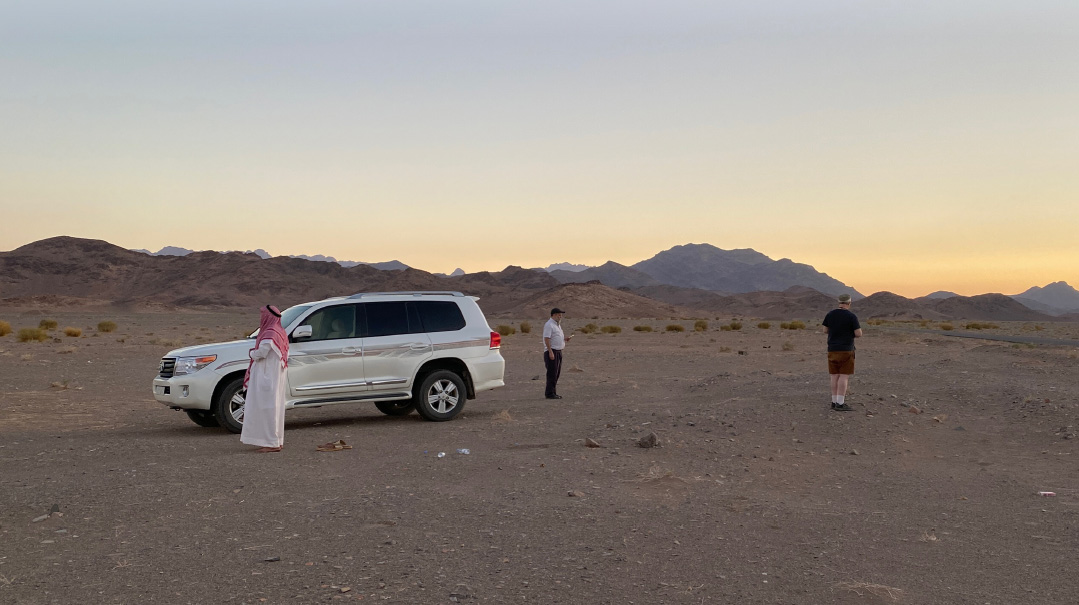
Minchah in the desert, each one in his own corner
Beyond the Competition
Visiting a religious country does have its advantages. While jeeping through the desert, we didn’t hesitate to tell our guide that it was Minchah time. He too wanted to “daven” before sunset. So there we were — just the three of us — in the northwestern Saudi Arabian desert. We got out of the jeep and faced northwest toward Yerushalayim, while he faced southeast toward Mecca.
The first Saudi state was formed by Muhammad bin Saud Al Muqrin in the 1700s, was taken over by the Ottomans and then the Egyptians, and modern Saudi Arabia is still ruled by the Al Saud family who make up the Royal House, numbering about 15,000. The Royal family and its friends are the wealthy aristocracy, and there is essentially no end of money in the oil-rich kingdom. Every citizen gets money and a house when married, plus a monthly payment from the state. Medical services are free, as is education, there’s no income tax, and gasoline costs 50 cents a liter — but the thing is that only about 60 percent of the population are citizens.
The wealthy billionaires flaunt their money with palaces beyond imagination and extravagant private jets. But it turns out that the perennial problem of kings holding onto their kingdoms and money affects the modern monarchy as well. There is constant concern of a revolt and overthrow of the ruling cabal. Punishment is harsh and as a result there is virtually no crime. Starting in 2017, Crown Prince Mohammed bin Salman al Saud, known as MBS, incarcerated a hundred of the wealthiest Saudis and confiscated over $100 billion in a “corruption purge” in financial “settlements.” No one dares criticize the country or royal family lest they be put in jail. As we passed a small prison, our guide told us, “the prisons are wonderful here, almost like a hotel.”
Saudi Arabia understands that without major changes, once oil either runs out or is replaced by another power source it will recede into the sands. Thus the recent huge investments in development, business, and science, to make Saudi Arabia a world business and destination hub, in the UAE model.
We got to see a very early phase of that plan. MBS has a vision of building a huge new city called Neom, that he envisions being 33 times the size of New York City. At present Neom is a city on paper — and exactly in the area of the supposed Har Sinai, in the Tabuk region. It will be a mega city, completely high tech, energy independent, with a free-trade zone. It is intended to sit in the mountains and extend to the Red Sea, a mere 45 minutes south of Aqaba, and by extension, Eilat. Huge roads are being cut through the desert, and although we saw few people (our guide arranged permission for us to enter the closed Neom construction zone), we did spot a caravan of Range Rovers filled with international design experts helping plan Neom.
We spent the night at a dive center that has been closed to tourists because of Neom. But at 6 a.m. on our way out we met a German deep-sea diver who has spent 20 years doing underwater archeology in Egypt and is now evaluating the coastline for Neom. Apparently 20,000 people in this sparsely populated area will have to be resettled, which in an absolute monarchy is never a problem. It promises to be an interesting few years in Saudi Arabia, as this controversial, very expensive project starts to take shape.
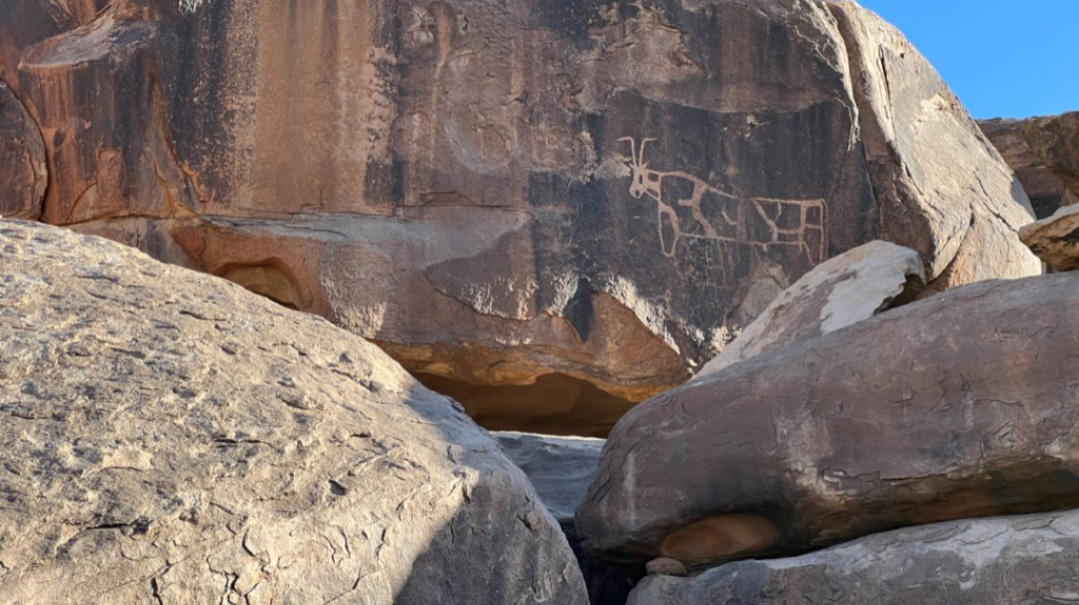
We couldn’t be sure, but according to Saudi tradition, we were at the spot where the Eigel was fashioned, and maybe we even traversed downtown Midian (left)
Sacred Cows
We continued to drive to one of the proof sites mentioned by various scholars, the so-called “Golden Calf petroglyph.” As we drove toward it we noticed a fenced-in area with a sign telling us that it was an archeological site under the auspices of the Saudi Commission for Tourism & Antiquities. We entered the site to find a mound of large rocks, many of them with ancient drawings of bulls and people worshiping bulls. Proponents of the theory argue that this is the site where the Jews worshipped the Golden Calf and that these are drawings they left. While the believers view these as solid proof of the biblical account, the doubters claim that these drawings long predate the Exodus and have nothing to do with the Eigel Hazahav. While we cannot give an educated opinion as to the dating of the petroglyphs, we can attest to the excitement of seeing such drawings in the middle of the desert.
We visited several other sites that according to local Saudi tradition are connected to the Exodus story. The Tayeb Ism Valley, with steep stone walls on either side, juts up from the white beaches of Aqaba, as a pastoral brook of fresh water flows through this stunning passage and out to the sea, papyrus plants growing the entire length. Christian researchers and others who claim Har Sinai is in this region believe the crossing of the Yam Suf was actually at the nearby Gulf of Aqaba and not the Gulf of Suez. Both are called the Red Sea, and in fact, in the passage (I Melachim 9:26) that discusses Shlomo Hamelech’s fleet, Yam Suf is clearly the Gulf of Aqaba/Eilat. The diver we met in the Neom construction zone, however, said he was unfamiliar with any of the supposed underwater evidence showing that Pharaoh’s army had pursued the Jews across this eastern arm of the Red Sea.
Whether or not this was the actual path to Har Sinai, it was a truly spectacular tiyul in the cool shade of the early morning before the sun was high.
According to both Saudi tradition and some historical research, this territory bordering the eastern shore of the Gulf of Aqaba is the ancient land of Midian, where Moshe spent ten years after fleeing from Egypt, which would put it within proximity to Har Sinai/Chorev, where he encountered the Burning Bush. It is speculated that when Moshe led Bnei Yisrael through the Red Sea onward to Har Sinai, they reached the land of Midian at Tayeb Al-Ism, which is also called the “Valley of Moses” and the nearby wells, the “Wells of Moses.”
We were then taken to an area with many upright stones, almost like pillars, which is the supposed graveyard of the eirev rav, the mixed multitude of sinners who left Egypt with Bnei Yisrael and were the cause of the sin of the Golden Calf.
Rocks of Ages
In Saudi tradition, the rock Moshe hit to hydrate the nation after crossing the Yam Suf is also nearby (lending credence to the Saudi-preferred theory that the sea actually split at its eastern wing, at Aqaba). It’s a steep mountain with a huge, several meter-high rock on top that’s split down the middle. We hiked up to the top of the hill, and our friend Howard Schwartz, who joined us, made a fascinating point. Surrounding the mountain are plains big enough to hold the entire population of the Exodus. But how could the people gain access to the water if it was all in one spot? Surrounding the split-rock mountain were large swaths of land with deep ravines that cut through and around the plains. He suggested that the water came out of the rock and flowed into these ravines, essentially creating rivers that allowed all of the people access to the drinking water. Whether this was the real site or not, it was edifying to try to really envision what it must have been like. (Others put the rock near Petra in Jordan — also on the path to Har Sinai in this area — a huge boulder that still has constant running water coming out of the cracks. Chassidim and others on their way to the kever of Aharon HaKohein use the water that pools under the rock as a mikveh.)
Mostly, though, we wanted to see the mountain itself. Would we actually get a glimpse of Har Sinai? Our driver knew the approximate direction, but had great difficulty finding it. After all, there are no roads and no signs deep in the desert. We drove in a jeep going around one mountain after another. We found a Bedouin camel breeder who would only tell us for money. Some bills changed hands, and off we went. We got lost again, but finally we saw it in the distance. As claimed, it has a blackened peak as if scorched by an intense fire, the result, according to the proponents of this theory, of when the mountain was enveloped in smoke, fire, and thunder during the giving of the Ten Commandments.
While Saudi tradition might have gone too far with their biblical sites — our guide showed us a deep well and told us it was the spot where Moshe met Yisro’s daughters — there is no question that Yisro in Midian was not too far from Har Sinai.
Secret Sinai
While the majority of scholars don’t believe Har Sinai was in Saudi Arabia — it would likely have taken more than three months for the entire nation to walk so far, and when they left Egypt, they started on the Mediterranean coastal route toward Eretz Yisrael and then seem to have made a U-turn, causing the Egyptians to think we were lost — the modern Jabal Al Lawz area is still called Midian in the Arabic of the locals.
And although it makes no practical difference to us which theory of Har Sinai is correct, it’s the search itself that was fascinating. But what was most meaningful to us is the fact that 3,500 years ago, Moshe Rabbeinu went up to Har Sinai, and with the entire nation encamped around, brought to Am Yisrael its greatest treasure. Whether it was on this hill or that mountain doesn’t change the essential truth of our tradition — and maybe not knowing exactly which humble hill it was, is exactly how Hashem wanted it….
(Originally featured in Mishpacha, Issue 948)
Oops! We could not locate your form.



